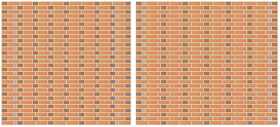The
simplest and most common patterns in modern masonry construction are running
bond and stack bond. In running bond, masonry units in one course are centred
over the head joints in the course below. As any child who’s experimented with
blocks knows, this interlocking pattern helps distribute loads and makes the
structure more robust. In stack bond, masonry units line up directly with those
in the course below. The continuous head and bed joints give the masonry a
distinct grid pattern that can have a pleasing aesthetic, particularly when the
mortar joints are raked. However, masonry constructed in stack bond is weaker
and less robust than masonry constructed in running bond. That said, a
carefully designed structure that properly utilizes the modular dimensions of
concrete blocks can potentially be less expensive to build in stack bond
pattern than in running bond pattern because there’s no need to cut half-blocks
at openings.
Figure
1: Running Bond (left) and Stack Bond (right).
Variations of running bond where the offset from one course to the next is
somewhere between half a unit (ordinary running bond) and zero (stack bond) are
also fairly common. While there could be an infinite number of possibilities
here, the most common running bond variants are one-third running bond (1/3
offset) and one-quarter running bond (1/4 offset).
Figure
2: One-Third Running Bond (left) and One-Quarter Running Bond (right).
In
addition to the patterns still in common use, there are dozens of other
possible patterns; too many to discuss. Some of which were common in the past
when multi-wythe construction was common, and some are rare patterns that were
simply invented to create unique aesthetics. Below are just a few examples of
the different patterns in existence:
| Figure 3 (from left to right): 45° Herringbone Bond, Diagonal Bond, Double Basket Weave Bond, and Pinwheel Bond. |
 |
| Figure 4: American Bond (left) and Scottish Bond (right). Headers shown in brown, stretchers in orange, and queen closers in grey. |
 |
| Figure 5: English Bond (left) and Flemish Bond (right). Headers shown in brown, stretchers in orange, and queen closers in grey. |
 | |
| Figure 6: Monk Bond (left) and Sussex Bond (right). Headers shown in brown, stretchers in orange, and queen closers in grey. |
References
BIA.
(1975). Technical Note 2: Glossary of
Terms Relating to Brick Masonry. Brick Industry Association, Reston, VA.
BIA.
(1999). Technical Note 30: Bonds and
Patterns in Brickwork. Brick Industry Association, Reston, VA.
Brunskill,
R. W. (1997). Brick Building in Britain.
Gollancz, London, UK.
Hatzinikolas,
M. A. and Korany, Y. (2005). Masonry
Design for Engineers and Architects. Canadian Masonry Publications,
Edmonton, Alberta.
Lloyd,
N. (1925). A History of English Brickwork.
Antique Collectors’ Club, Woodbridge, UK.


My ex-husband and I had always managed to stay friendly after our divorce in February 2017. But I always wanted to get back together with him, All it took was a visit to this spell casters website last December, because my dream was to start a new year with my husband, and live happily with him.. This spell caster requested a specific love spell for me and my husband, and I accepted it. And this powerful spell caster began to work his magic. And 48 hours after this spell caster worked for me, my husband called me back for us to be together again, and he was remorseful for all his wrong deeds. My spell is working because guess what: My “husband” is back and we are making preparations on how to go to court and withdraw our divorce papers ASAP. This is nothing short of a miracle. Thank you Dr Emu for your powerful spells. Words are not enough. here is his Email: emutemple@gmail.com or call/text him on his WhatsApp +2347012841542
ReplyDeleteHe is also able to cast spell like 1: Lottery 2: Conceive 3: Breakup 4: Divorce 5: Cure for all kinds of diseases and viruses.